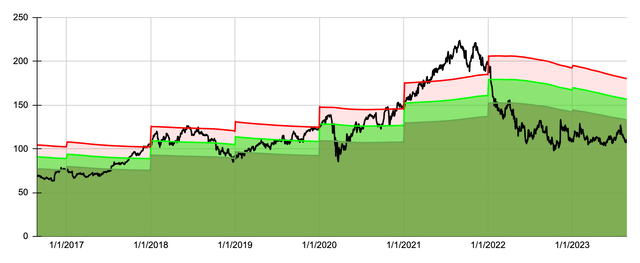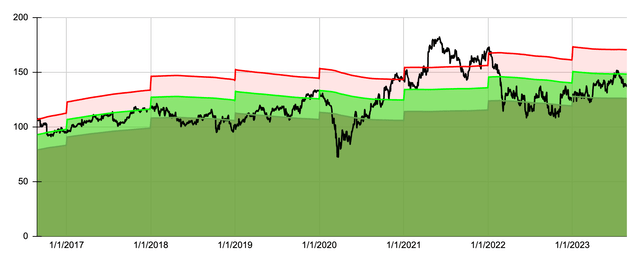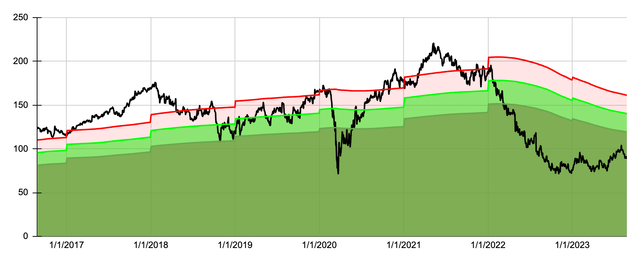2023 Review
The second half of the year kicked off nicely for the Dividend Aristocrats, in July the ProShares S&P 500 Dividend Aristocrats ETF (NOBL) ticked up 2.59%. This good start was short lived as all of the July gains have been lost in August as the overall market is slipping. Year-to-date through month-end July NOBL is up 8.46%, inclusive of partial August the year-to-date return drops to 5.22%.
Let’s take a look at which individual aristocrats are driving the return in 2023; 32 dividend aristocrats are beating NOBL through month-end July, and 45 are generating positive total returns this year. These aristocrats are outpacing NOBL after July:
- West Pharma (WST) +56.67%
- Pentair (PNR) +56.39%
- Stanley Black & Decker (SWK) +34.72%
- W.W. Grainger (GWW) +33.46%
- Nucor Corp. (NUE) +31.42%
- A. O. Smith (AOS) +28.62%
- Ecolab (ECL) +26.62%
- Brown & Brown (BRO) +24.13%
- Illinois Tool Works (ITW) +20.81%
- Linde plc (LIN) +20.67%
- Cardinal Health (CAH) +20.40%
- Church & Dwight (CHD) +19.41%
- Lowe’s (LOW) +19.35%
- Expeditors International of Washington (EXPD) +19.13%
- S&P Global (SPGI) +18.40%
- Essex Property Trust (ESS) +17.38%
- Sherwin-Williams (SHW) +17.13%
- T. Rowe Price Group (TROW) +15.56%
- PPG Industries (PPG) +15.52%
- Medtronic (MDT) +14.80%
- Roper Technologies (ROP) +14.63%
- Walmart (WMT) +13.65%
- Franklin Resources (BEN) +13.36%
- McDonald’s (MCD) +12.47%
- Caterpillar (CAT) +12.39%
- Cintas (CTAS) +11.73%
- C.H. Robinson Worldwide (CHRW) +10.77%
- Becton, Dickinson (BDX) +10.38%
- Atmos Energy (ATO) +9.99%
- Clorox (CLX) +9.63%
- McCormick (MKC) 8.95%
- Dover Corp. (DOV) +8.57%
The S&P 500, as measured by SPDR® S&P 500 ETF Trust (SPY), was up 3.27% in July but is down 3.28% through August 28th. NOBL beat SPY in 2022 with a loss of 6.5% compared to a loss of 21.65%. SPY started 2023 on a stronger footing and is beating NOBL by 11.44% year-to-date through August 28th. The dividend aristocrats are not known to consistently beat the S&P 500 index, in fact, the dividend aristocrat index underperformed the S&P 500 index for 6 out of the last 8 full calendar years.
However, if you look further back in history, the dividend aristocrat index is outperforming the S&P 500 index by about 2.18% per year between 1990 and 2022. A significant portion of this long-term outperformance is attributable to the dot com bubble and the financial crisis as well as the immediate years following each market crash. This pattern was broken with the 2020 market crash, perhaps the much shorter duration of the crash and recovery are the reason. The dot com bubble and the financial crisis both extended for multiple years while the 2020 market crash was fully recovered in a matter of months. 2022 also proved to be a strong year for the aristocrats as they earned 15.15% of alpha on the S&P, making up for 3 years of underperformance.
Even though the dividend aristocrats have trailed the S&P for the better part of the last 8 years, long-term investors can rest assured that based on history, over a much longer time period, the dividend aristocrats can hold their own. There are currently 67 companies in the dividend aristocrat index but strong historical returns for the index can be attributed to only a handful of them. As an investor, I am always curious how to identify these drivers of outperformance.
I want to present 3 strategies that theoretically could identify winning aristocrats and lead to better performance than the dividend aristocrat index. These strategies work best with a buy and hold long-term investing approach as will be evidenced by the results. They are based on quantitative models that do not consider qualitative data; therefore it is prudent that further due diligence is performed on all chosen stocks.
The Most Undervalued Strategy
Strategy number 1 is a focus on valuation and more specifically it targets the potentially most undervalued dividend aristocrats. In theory, this is a long-term strategy since it may take some time to fully see the reward of leveraging a valuation approach. My preferred method for valuation is dividend yield theory, mainly for its simplicity. Unlike other valuation methods, dividend yield theory does not require making assumptions aside from assuming that a given stock will revert back to its long-term trailing dividend yield.
This valuation technique works best for mature businesses with long histories of dividend growth, making the dividend aristocrats an ideal pool of companies to value using this technique.
Selecting the 10 most undervalued dividend aristocrats each month and adopting a buy and hold investing approach can lead to long-term outperformance when/if the targeted stocks return to fair valuation. It may take a few months or even years to see if this strategy actually pays off. I predict that it will underperform NOBL for the first few months while we wait for bargain stocks to return to fair value.
|
Month |
Most Undervalued |
NOBL |
SPY |
|
Aug 21 |
0.49% |
1.87% |
2.98% |
|
Sep 21 |
-2.99% |
-5.69% |
-4.66% |
|
Oct 21 |
3.63% |
5.95% |
7.02% |
|
Nov 21 |
-2.19% |
-1.76% |
-0.80% |
|
Dec 21 |
10.37% |
6.54% |
4.63% |
|
Jan 22 |
1.04% |
-4.08% |
-5.27% |
|
Feb 22 |
-1.94% |
-2.59% |
-2.95% |
|
Mar 22 |
3.40% |
3.86% |
3.76% |
|
Apr 22 |
-2.14% |
-3.42% |
-8.78% |
|
May 22 |
3.11% |
0.31% |
0.23% |
|
Jun 22 |
-7.30% |
-6.73% |
-8.25% |
|
Jul 22 |
5.00% |
6.56% |
4.55% |
|
Aug 22 |
-3.25% |
-2.78% |
-4.08% |
|
Sep 22 |
-11.39% |
-9.15% |
-9.24% |
|
Oct 22 |
10.07% |
10.31% |
8.13% |
|
Nov 22 |
6.99% |
7.12% |
5.56% |
|
Dec 22 |
-5.41% |
-4.12% |
-5.76% |
|
Jan 23 |
4.83% |
3.23% |
6.29% |
|
Feb 23 |
-3.33% |
-2.36% |
-2.51% |
|
Mar 23 |
-0.86% |
0.99% |
3.71% |
|
Apr 23 |
3.06% |
2.12% |
1.60% |
|
May 23 |
-7.87% |
-5.90% |
0.46% |
|
Jun 23 |
7.17% |
8.08% |
6.48% |
|
Jul 23 |
3.27% |
2.59% |
3.27% |
|
Aug 23 |
-5.31% |
-2.99% |
-3.28% |
|
2021 Partial |
9.05% |
6.54% |
9.06% |
|
2022 |
-3.91% |
-6.50% |
-21.65% |
|
2023 |
-0.04% |
5.22% |
16.66% |
|
TOTAL |
4.74% |
4.81% |
-0.32% |
|
Alpha over NOBL |
-0.07% |
||
|
Alpha over SPY |
5.06% |
The table above shows the monthly and annual returns for the buy-and-hold portfolio of the most undervalued strategy.
The portfolio beat NOBL in July by 0.68% and finished even with SPY. August, on the other hand, is looking much worse, the portfolio is down 5.31% through August 28th. While NOBL is down 2.99% and SPY is down 3.28%. Year-to-date the portfolio continues to underperform both NOBL and SPY. And for the first time in a very long time the portfolio falls behind NOBL since inception, losing by 0.07% through partial August. The partial August returns are price returns only and not inclusive of any dividends paid during the month. The portfolio continues to maintain a modest level of alpha over SPY, 5.06%, but it has certainly hit a dry spell here in 2023.
The portfolio consists of 39 unique present and former dividend aristocrats. I track this portfolio by investing $1,000 each month equally split among the 10 chosen aristocrats for that month. The positions are never trimmed or sold and all dividends are reinvested back into the issuing stock.
Here are the 10 most undervalued dividend aristocrats chosen for the month of September 2023. The table below shows potential undervaluation (column Over/Under) for each of the 10 chosen aristocrats. The image below is taken from a new spreadsheet I recently created where I am self-computing the 5-year trailing dividend yield. Previously I used Seeking Alpha as a source for the historical yield.
Created by Author
Please note that V.F. Corporation (VFC) cut its dividend earlier this year and will highly likely be removed from the dividend aristocrat list at its reconstitution early next year.
Here is a closer look at T. Rowe Price Group.
TROW currently looks to be approximately 30% undervalued. In the image below the black line is the actual price since July of 2016. The light green shaded area represents a 0 to 15% undervalued zone. The dark green area represents an undervaluation in excess of 15%. The light red shaded area represents a 0 to 15% overvalued zone.
Created by Author
An estimated daily return test for the period August 2016 through August 2022 yielded positive results in the application of dividend yield theory as a valuation tool. The average return of investing in the stock on all days when the stock appeared to be undervalued was 2.89%. The average return of investing in the stock on all days regardless of valuation was -2.11%. And the average return of investing in the stock on all days when it appeared overvalued was -7.40%. TROW peaked in price during the 2021 stock market rally, moving high into the overvalued zone. In 2022 the share price came tumbling but has consolidated around its current range in the deep undervalued zone.
In 2021 TROW’s dividend yield bottomed out dipping below 2%, today it sits comfortably above 4%, presenting dividend investors with one of the most opportune entry points in the past 7 years.
The Fastest Expected Growth Strategy
Strategy number 2 is a focus on dividend aristocrats that are expected to grow the fastest in the near future. Historically, there has been a correlation between earnings per share growth and share price appreciation. Companies that have grown their earnings faster have also seen higher total returns. One way to gauge how fast earnings for a company will grow is to leverage analyst forecasts. For this strategy, I decided to use a discounted five-year EPS growth forecast combined with a return to fair valuation and the dividend yield to identify the 10 best aristocrats poised for the best total return in the future.
|
Month |
Fastest Growth |
NOBL |
SPY |
|
Aug 21 |
5.12% |
1.87% |
2.98% |
|
Sep 21 |
-4.42% |
-5.69% |
-4.66% |
|
Oct 21 |
5.92% |
5.95% |
7.02% |
|
Nov 21 |
-2.06% |
-1.76% |
-0.80% |
|
Dec 21 |
7.09% |
6.54% |
4.63% |
|
Jan 22 |
-4.42% |
-4.08% |
-5.27% |
|
Feb 22 |
-0.10% |
-2.59% |
-2.95% |
|
Mar 22 |
3.71% |
3.86% |
3.76% |
|
Apr 22 |
-2.19% |
-3.42% |
-8.78% |
|
May 22 |
0.12% |
0.31% |
0.23% |
|
Jun 22 |
-8.94% |
-6.73% |
-8.25% |
|
Jul 22 |
6.09% |
6.56% |
4.55% |
|
Aug 22 |
-2.69% |
-2.78% |
-4.08% |
|
Sep 22 |
-11.37% |
-9.15% |
-9.24% |
|
Oct 22 |
13.68% |
10.31% |
8.13% |
|
Nov 22 |
6.14% |
7.12% |
5.56% |
|
Dec 22 |
-7.53% |
-4.12% |
-5.76% |
|
Jan 23 |
9.41% |
3.23% |
6.29% |
|
Feb 23 |
-3.01% |
-2.36% |
-2.51% |
|
Mar 23 |
-1.79% |
0.99% |
3.71% |
|
Apr 23 |
0.37% |
2.12% |
1.60% |
|
May 23 |
-7.21% |
-5.90% |
0.46% |
|
Jun 23 |
11.17% |
8.08% |
6.48% |
|
Jul 23 |
3.00% |
2.59% |
3.27% |
|
Aug 23 |
-3.47% |
-2.99% |
-3.28% |
|
2021 Partial |
11.62% |
6.54% |
9.06% |
|
2022 |
-9.86% |
-6.50% |
-21.65% |
|
2023 |
7.29% |
5.22% |
16.66% |
|
TOTAL |
7.95% |
4.81% |
-0.32% |
|
Alpha over NOBL |
3.13% |
||
|
Alpha over SPY |
8.27% |
The table above shows the monthly and annual returns for the buy-and-hold portfolio of the fastest expected growth strategy.
The portfolio outpaced NOBL by 0.41% but not SPY in July, losing to the latter by 0.27%. August thus far is looking a little worse, the portfolio is down 3.47% through August 28th. While NOBL is down 2.99% and SPY is down 3.28%. Year-to-date the portfolio continues to outpace NOBL but trails SPY by a wide margin. However, since inception, it maintains a modest level of alpha over both, 3.13% over NOBL and 8.27% over SPY.
The portfolio consists of 34 unique present and former dividend aristocrats. I track this portfolio by investing $1,000 each month equally split amongst the 10 chosen aristocrats for that month. The positions are never trimmed or sold and all dividends are reinvested back into the issuing stock. People’s United was removed from the portfolio in April 2022, as the company was acquired by M&T Bank (MTB); the value of the position was reinvested equally amongst the 10 chosen aristocrats for April.
Here are the 10 dividend aristocrats poised for the best total return for the month of September 2023. The table below shows the expected growth rate (column EPS + Valuation) for each of the 10 chosen aristocrats.
Created by Author
Here is a closer look at PPG Industries. Below is the 7-year dividend yield theory chart.
Created by Author
The average return of investing in the stock on all days when it appeared to be undervalued was 7.19%. The average return of investing in the stock on all days regardless of valuation was 4.30%. And the average return of investing in the stock on all days when it appeared overvalued was -2.08%. PPG has trended nicely in 2023 moving from the deep undervalued zone into the light green undervalued zone, still presenting a good entry point based on dividend yield theory.
The stock was available with a starting dividend yield in excess of 2% during 2022 and early 2023 but has recently trended closer to its long term average yield of 1.75%.
The Blended Strategy
Strategy 3 is a blend of the first two strategies, with a focus on the fastest expected growth but applied only to undervalued aristocrats. A blend of undervaluation and expected growth could narrow down the best aristocrats between the two strategies. The most undervalued aristocrats may not necessarily be poised for the fastest growth. Additionally targeting only undervalued aristocrats can offer a margin of safety in that securities are purchased for fair or better prices.
|
Month |
Blended |
NOBL |
SPY |
|
Aug 21 |
2.64% |
1.87% |
2.98% |
|
Sep 21 |
-3.42% |
-5.69% |
-4.66% |
|
Oct 21 |
2.70% |
5.95% |
7.02% |
|
Nov 21 |
-2.56% |
-1.76% |
-0.80% |
|
Dec 21 |
10.07% |
6.54% |
4.63% |
|
Jan 22 |
-0.71% |
-4.08% |
-5.27% |
|
Feb 22 |
0.49% |
-2.59% |
-2.95% |
|
Mar 22 |
3.48% |
3.86% |
3.76% |
|
Apr 22 |
-5.04% |
-3.42% |
-8.78% |
|
May 22 |
1.28% |
0.31% |
0.23% |
|
Jun 22 |
-6.23% |
-6.73% |
-8.25% |
|
Jul 22 |
4.56% |
6.56% |
4.55% |
|
Aug 22 |
-3.29% |
-2.78% |
-4.08% |
|
Sep 22 |
-10.88% |
-9.15% |
-9.24% |
|
Oct 22 |
9.97% |
10.31% |
8.13% |
|
Nov 22 |
6.38% |
7.12% |
5.56% |
|
Dec 22 |
-5.32% |
-4.12% |
-5.76% |
|
Jan 23 |
4.15% |
3.23% |
6.29% |
|
Feb 23 |
-3.45% |
-2.36% |
-2.51% |
|
Mar 23 |
-0.31% |
0.99% |
3.71% |
|
Apr 23 |
2.31% |
2.12% |
1.60% |
|
May 23 |
-6.64% |
-5.90% |
0.46% |
|
Jun 23 |
8.48% |
8.08% |
6.48% |
|
Jul 23 |
3.38% |
2.59% |
3.27% |
|
Aug 23 |
-3.97% |
-2.99% |
-3.28% |
|
2021 Partial |
9.18% |
6.54% |
9.06% |
|
2022 |
-7.04% |
-6.50% |
-21.65% |
|
2023 |
3.11% |
5.22% |
16.66% |
|
TOTAL |
4.65% |
4.81% |
-0.32% |
|
Alpha over NOBL |
-0.16% |
||
|
Alpha over SPY |
4.97% |
The table above shows the monthly and annual returns for the buy-and-hold portfolio of the blended strategy.
The portfolio delivered a strong return in July of 3.38%, it beat NOBL by 0.79% and SPY by 0.11%. August is shaping up to be a worse month as the portfolio is down 3.97% through August 28th, and trailing NOBL by 0.98% and SPY by 0.69%. Since inception the portfolio has struggled to remain ahead of NOBL and once more after a sour August falls behind the benchmark, trailing NOBL by 0.16%. The portfolio is still maintaining a decent lead over SPY of 4.97% but year-to-date it trails the fund by 13.55%.
The portfolio consists of 39 unique present and former dividend aristocrats. I track this portfolio by investing $1,000 each month equally split amongst the 10 chosen aristocrats for that month. The positions are never trimmed or sold and all dividends are reinvested back into the issuing stock. People’s United was removed from the portfolio in April as the company was acquired by M&T Bank; the value of the position was reinvested equally amongst the 10 chosen aristocrats for April.
Here are the 10 dividend aristocrats chosen for the blended strategy for September 2023. The table below shows potential undervaluation (column Over/Under) and the expected growth rate (column EPS + Valuation) for each of the 10 chosen aristocrats.
Created by Author
Here is a closer look at Stanley Black & Decker. Below is the 7-year dividend yield theory chart.
Created by Author
The average return of investing in the stock on all days when it appeared to be undervalued was -11.50%. The average return of investing in the stock on all days regardless of valuation was -12.61%. And the average return of investing in the stock on all days when it appeared overvalued was -12.99%. Stanley Black & Decker took a beating in 2022, dropping my more than 50%. In late 2022 and early 2023 the share price consolidated around the $75 range and has since seen some positive traction. Year-to-date the stock is up nearly 35% as is the 3rd best dividend aristocrat to own.
The stock still sports a historically high dividend yield in excess of 3%, nearly as high as its yield during the 2020 pandemic lows.
Performance Review
The 10 chosen aristocrats for the most undervalued strategy are down 6.36% in August and trailing NOBL by 3.37%. The fastest expected growth strategy selections are down 3.67% and trailing NOBL by 0.38%. And the blended strategy selections are down 4.99% and trailing NOBL by 2.00%. The fastest expected growth strategy is off to the best start this year, seeing positive gains in 6 out of the 8 months thus far. The individual selections are also fairing much better than the long-term buy-and-hold portfolios, with the year-to-date return being 24.56% through August 28th. However, I still believe that a buy-and-hold approach is the optimal investing path to take with these strategies.
Here is a comparison of the buy-and-hold portfolios and the individual monthly selections for each strategy. As you can see the buy-and-hold portfolios are still performing much better than if we bought and sold the 10 chosen aristocrats each month. A buy-and-hold approach is also a much more tax-friendly investing strategy.
|
Type |
Most Undervalued |
Fastest Growth |
Blended |
NOBL |
|
Individual |
-3.43% |
14.59% |
5.72% |
4.81% |
|
Buy-and-Hold |
4.74% |
7.95% |
4.65% |
4.81% |
|
O/U |
8.17% |
-6.64% |
-1.07% |
0.00% |
Final Thoughts
I personally believe each of the 3 strategies outlined above can theoretically beat the dividend aristocrat index over a long period of time. These strategies are based on simple principles of valuation and expected returns, and they are easy to understand and implement. Investors should keep in mind that selecting individual stocks carries more risk than investing in an index. The simplest and possibly the safest way to invest in the dividend aristocrats is to purchase shares of NOBL. The fund finished 2021 with a fantastic return, performed much better than the S&P in 2022 and has an annualized rate of return of 10.87% since inception.
2023 is shaping up to be an interesting year for dividend strategies. The S&P 500 had a very poor return in 2022 and seems to be bouncing back this year, driven by strong returns from technology stocks. Dividends aristocrats fared much better in 2022 but got off to a poor start this year. Dividend investing is a marathon, not a sprint and you will find yourself in a slow period from time to time. The best course of action is to stick with your long-term strategy so long as it still fits your long-term objectives.
The dividend aristocrat data in the images of this article came from my live Google spreadsheet that tracks all of the current dividend aristocrats. Because this data is updated continuously throughout the day, you may notice slightly different data for the same company across the images. Also some of my returns may be off by a few basis points from those you’ll see from other sources on the web.
Read the full article here









